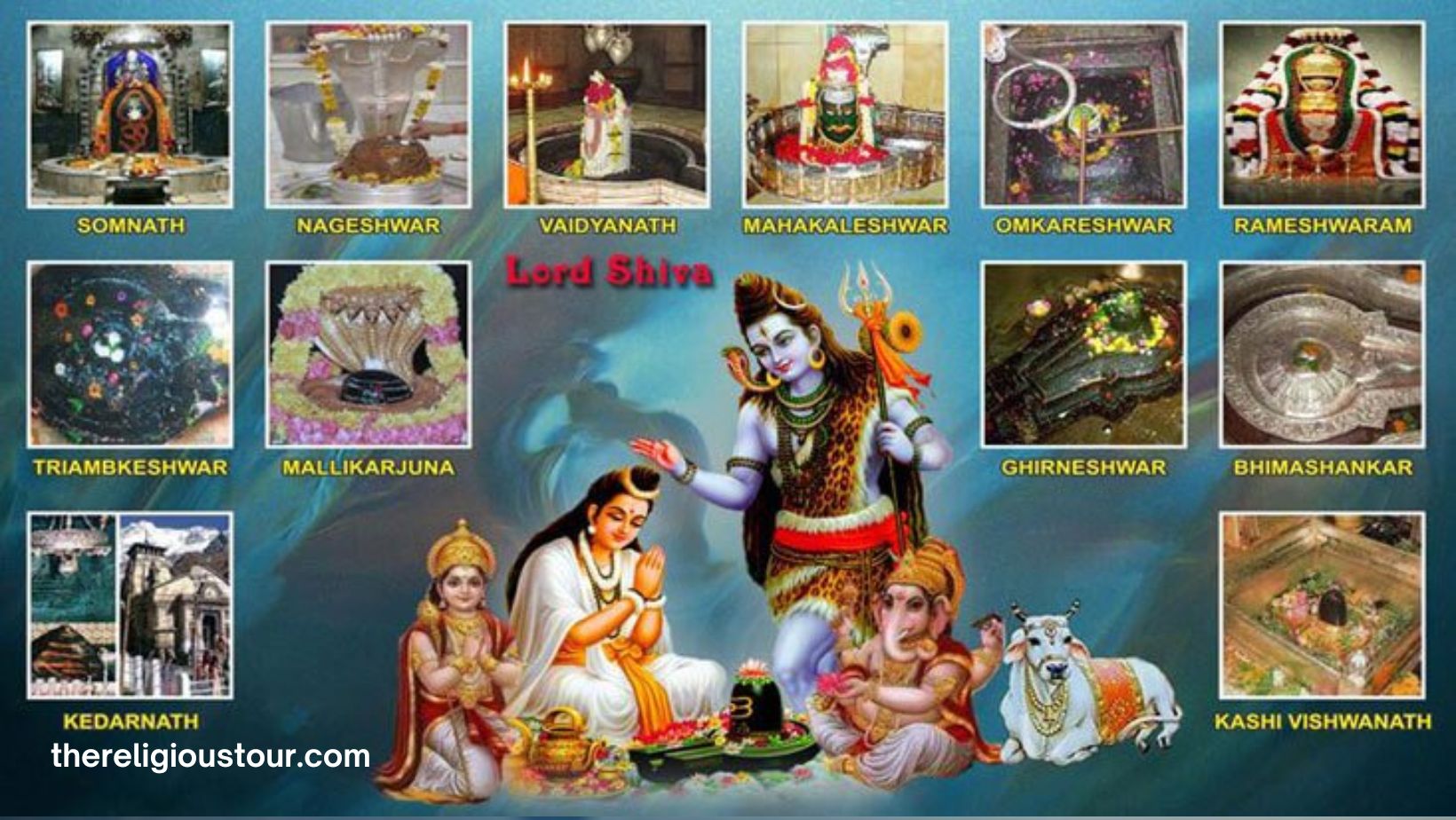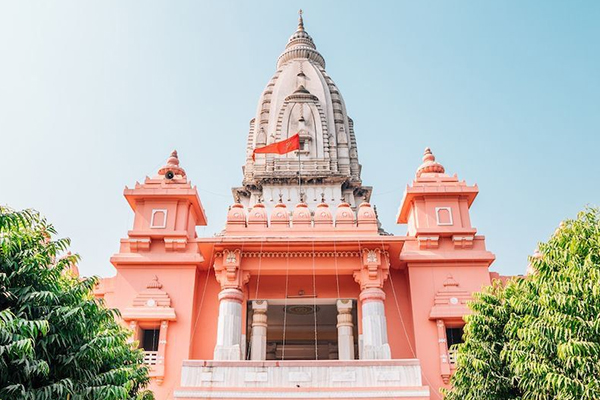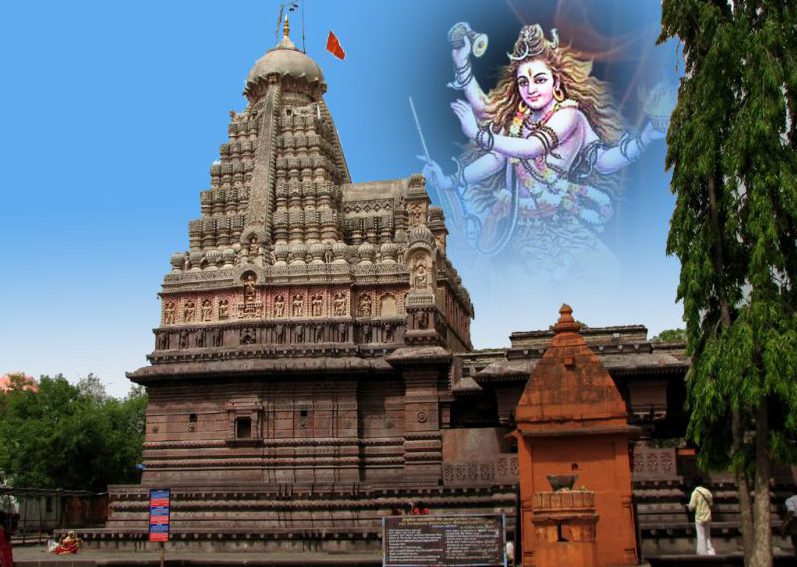Discovering Divine Bliss: How to Explore the 12 Jyotirlingas in India

Embarking on a spiritual odyssey through India’s sacred heartland is a journey of a lifetime. In this guide, we unveil the art of how to explore the 12 Jyotirlinga, the divine abodes of Lord Shiva. These sacred shrines, scattered across India, hold profound spiritual significance and awe-inspiring architecture. Join us on a quest to delve into centuries-old traditions, witness mesmerizing rituals, and bask in the spiritual aura of these holy sites. Discover the essence of devotion and transcendence as we navigate you through this sacred pilgrimage.
1. Somnath Temple, Gujarat: The Eternal Illumination
Our sacred voyage commences in the western region of Gujarat, at the hallowed grounds of the Somnath Temple. Nestled along the shores of the Arabian Sea in Prabhas Patan, this Jyotirlinga holds the distinction of being the foremost among the twelve. “Somnath,” which translates to ‘The Lord of the Moon,’ honors Lord Shiva as the ‘Eternal Illumination.’
 Also read – How to Explore Badrinath Dham and Uncover its Rich History & Culture
Also read – How to Explore Badrinath Dham and Uncover its Rich History & Culture
The temple’s architectural marvel marries Chalukyan and Solanki design influences, a testament to its rich historical and spiritual heritage. Delving into the Somnath Temple experience transcends mere quest for divine blessings; it’s an opportunity to embrace the serenity of the sea breeze and immerse oneself in the profound spiritual resonance that pervades this sacred site.
2. Mallikarjuna Temple, Andhra Pradesh: Where Divinity Meets Natural Beauty
Leaving Gujarat behind, we embark on a scenic expedition to the state of Andhra Pradesh, where we explore the Mallikarjuna Temple, peacefully situated in the serene Nallamala Hills. The Jyotirlinga enshrined within is referred to as “Mallikarjuna,” signifying the ‘Guardian of Jasmine.’ This name aptly befits a temple cocooned amidst verdant landscapes and perfumed blooms.
The journey to Mallikarjuna Temple is a blend of spiritual rejuvenation and natural exploration. The temple is located near the famous Bhramaramba Mallikarjuna Wildlife Sanctuary, offering a unique opportunity to connect with nature and spirituality in harmony.
3. Mahakaleshwar Temple, Madhya Pradesh: The Essence of Ujjain
Our sacred journey now brings us to Ujjain, a city nestled in the heart of Madhya Pradesh, where the resplendent Mahakaleshwar Temple graces the banks of the serene Shipra River. In this hallowed sanctuary, Lord Shiva is revered as “Mahakaleshwar,” the divine ‘Master of Time.’
The Mahakaleshwar Temple transcends its architectural brilliance, embodying the timeless cycle of existence – birth, demise, and resurgence. Renowned for its Bhasma Aarti, a ritual that veils the deity in ash, symbolizing the transitory nature of life, this temple invites you to embark on a profound exploration of Hinduism’s spiritual essence.
Also read – Exploring the Rich History and Culture of Kela Devi Temple in Karoli
4. Omkareshwar Temple, Madhya Pradesh: The Sacred Om
Continuing our journey in Madhya Pradesh, we arrive at Omkareshwar Temple. Located on an island in the Narmada River, this Jyotirlinga is named “Omkareshwar,” denoting the ‘Lord of Om.’ The shape of the island resembles the sacred symbol ‘Om,’ adding to its spiritual significance.
To reach the temple, one must take a boat ride across the serene Narmada, creating a unique and enchanting experience. The Omkareshwar Temple is not just a place of worship but also a testament to the seamless fusion of spirituality and nature’s beauty.
5. Kedarnath Temple, Uttarakhand: The Abode in the Himalayas
Our pilgrimage now ascends to the breathtaking Himalayan heights in Uttarakhand, where the Kedarnath Temple resides. Situated amidst snow-clad peaks and lush meadows, this Jyotirlinga is named “Kedarnath,” signifying the ‘Lord of the Field.’
The journey to Kedarnath Temple is not for the faint-hearted. Pilgrims trek through rugged terrains, reflecting their unwavering devotion. The temple itself stands as a testament to human perseverance in the face of nature’s challenges.
6. Bhimashankar Temple, Maharashtra: Amidst the Sahyadri Mountains
Descending from the Himalayas, we make our way to the Sahyadri Mountains in Maharashtra, where the Bhimashankar Temple awaits. Named “Bhimashankar,” meaning the ‘Lord of Bhima,’ this Jyotirlinga is surrounded by lush green forests.
Exploring Bhimashankar is a unique blend of spiritual contemplation and nature’s bounty. The temple’s location makes it a haven for trekkers and wildlife enthusiasts, allowing you to connect with the divine amidst the untamed beauty of the Western Ghats.
Also read – Exploring Shila Devi Temple in Amer: A Journey Through History and Faith
7. Kashi Vishwanath Temple, Uttar Pradesh: The Holiest of All
Following that, our expedition takes us to Varanasi, an ancient city with an uninterrupted history of human habitation. Here, we will explore the Kashi Vishwanath Temple, housing the revered Jyotirlinga known as “Vishwanath,” signifying the ‘Supreme Ruler of the Universe.’
 Also read – Salasar Balaji – The Tale of the Bearded Hanuman Avatar
Also read – Salasar Balaji – The Tale of the Bearded Hanuman Avatar
Varanasi, with its winding alleys and the spiritual aura of the Ganges, is a place where life and death coexist. Exploring Kashi Vishwanath Temple is a journey into the heart of Hindu spirituality and the ancient traditions that have thrived here for millennia.
8. Trimbakeshwar Temple, Maharashtra: The Source of Godavari
Our pilgrimage now takes us to Trimbak in Maharashtra, where the Trimbakeshwar Temple is nestled. This Jyotirlinga is known as “Trimbakeshwar,” denoting the ‘Three-Eyed Lord,’ a reference to Lord Shiva.
Trimbak is not only a place of worship but also the source of the sacred Godavari River. Exploring this temple allows you to witness the confluence of spirituality and the natural world, with the lush Godavari basin serving as a backdrop.
9. Vaidyanath Temple, Jharkhand: Healing and Devotion
We venture eastward to Deoghar in Jharkhand to visit the Vaidyanath Temple. This Jyotirlinga is known as “Vaidyanath,” the ‘Lord of Physicians,’ and it is believed to have the power to heal ailments.
Exploring Vaidyanath Temple is a unique experience where devotion and hope converge. The temple is adorned with exquisite architecture and surrounded by a peaceful aura, making it a place of solace and spiritual renewal.
Also read – Goganavami Special: A Glimpse into Gogamedi Mandir and the Vibrant Festival of Hanumangarh
10. Nageshwar Temple, Gujarat: The Benevolent Lord
Heading back to Gujarat, we encounter the Nageshwar Temple nestled along the tranquil shores of Saurashtra. This particular Jyotirlinga goes by the name “Nageshwar,” signifying the ‘Master of Serpents.’
The Nageshwar Temple stands not just as a sacred sanctuary but also as an emblem of Lord Shiva’s compassion. As you venture through its serene environs, accompanied by the soothing sounds of the Arabian Sea, you’ll discover a unique and unparalleled sense of tranquility.
11. Rameshwar Temple, Tamil Nadu: A Spiritual Sojourn
Our journey now takes us to the southern tip of India, to Rameswaram in Tamil Nadu. Here, the Ramanathaswamy Temple houses the Jyotirlinga known as “Rameshwar,” the ‘Lord of Rama.’
Rameswaram is not just a place of pilgrimage but also a historical and spiritual marvel. Exploring the temple’s intricate corridors and the turquoise waters of the Indian Ocean that surround it is a truly unique experience.
Also read – Why is Krishna Janmashtami Celebrated? Unveiling the Divine Joy of Janmashtami Celebration
12. Grishneshwar Temple, Maharashtra: The Last Divine Stop
Our final destination in this spiritual odyssey is Grishneshwar Temple in Maharashtra. Named “Grishneshwar,” which means ‘the Lord of Compassion,’ this Jyotirlinga is believed to bring solace to the devoted.

Exploring Grishneshwar is a journey into the heart of Maharashtra’s spiritual traditions. The temple’s exquisite architecture and the peaceful aura of the surrounding village create a serene atmosphere for reflection.
Also read – Explore Shirdi and Get Absorbed in Spiritual Serenity
Embarking on the Journey: Practical Tips
- Planning: Before setting out on this spiritual journey, plan your itinerary meticulously. Ensure you have adequate time and resources to explore each Jyotirlinga thoroughly.
- Accommodation: Look for accommodations that are close to each temple to make your visits convenient and comfortable.
- Transportation: India has a well-connected railway and road network. You can plan your travel between Jyotirlingas by train or hire a reliable car service.
- Timing: Check the opening and closing timings of each temple, as they may vary. It’s also advisable to inquire about any special rituals or festivals during your visit.
- Attire: As these are sacred places, dress modestly and respectfully. Many temples may have specific dress codes.
- Respect Local Customs: Be aware of and respect local customs and traditions, and seek guidance from locals when necessary.
- Stay Hydrated and Energized: This journey can be physically demanding, especially in regions with extreme climates. Stay hydrated and carry snacks for energy.
- Travel Documents: Ensure you have all your identification and travel documents in order, including any required permits for specific regions.
Also read – Unveiling the Remarkable Personality of Lakshman in Ramayana
Exploring the 12 Jyotirlingas in India is not just a pilgrimage; it’s a profound spiritual and cultural experience that connects you with the essence of Hinduism and the diverse landscapes of this incredible nation. Each Jyotirlinga has its own unique charm and significance, making this journey an unforgettable adventure of self-discovery and divine connection.
Tags: explore 12 jyotirlinga, explore 12 jyotirlinga in india, travel tips